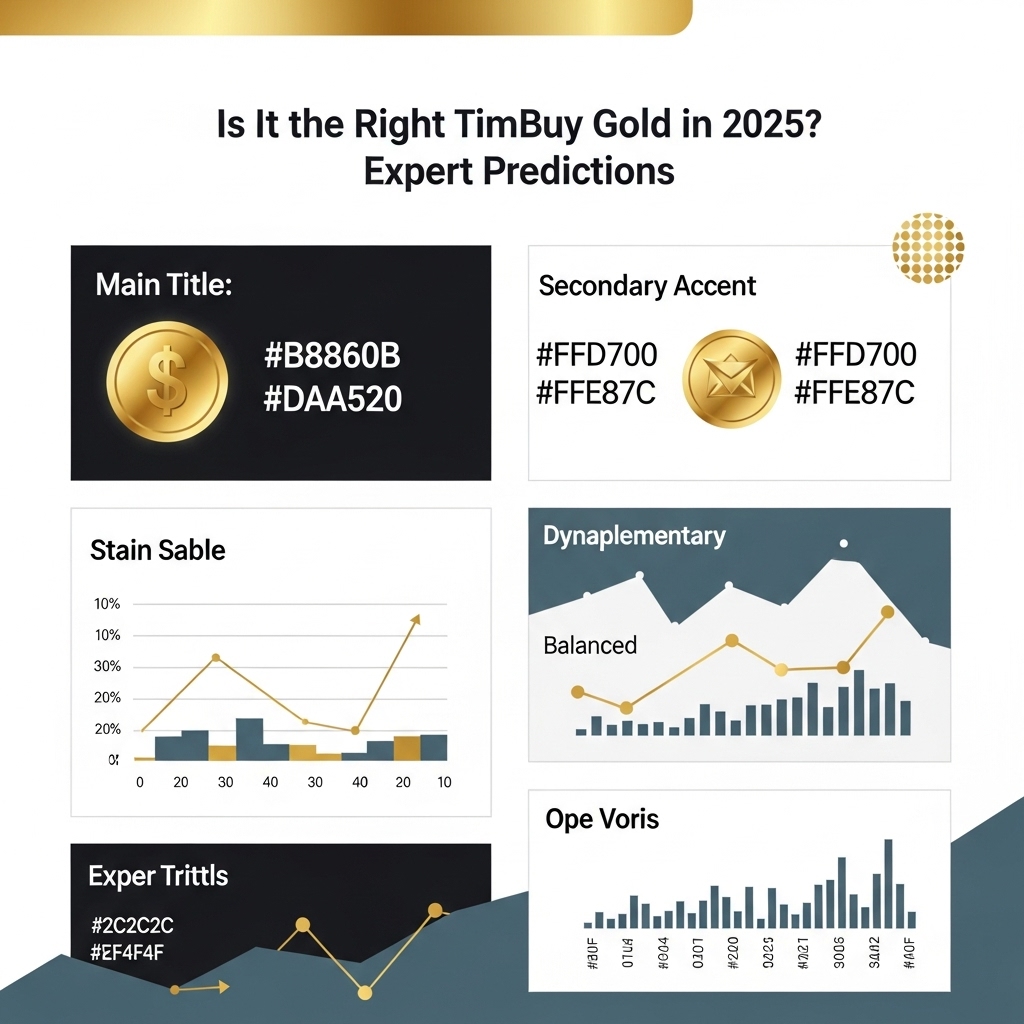Is It the Right Time to Buy Gold in 2025? Expert Predictions
In an era marked by shifting economic landscapes, geopolitical tensions, and persistent inflation concerns, gold has once again reaffirmed its status as the ultimate safe haven asset. With its price recently demonstrating remarkable resilience and even touching near all-time highs amidst global uncertainties, a critical question weighs on every astute investor’s mind: Is 2025 the opportune moment to solidify or expand your gold holdings? The timing of an investment can significantly dictate its financial outcomes, and understanding the future trajectory of gold is paramount for those looking to preserve wealth and capitalize on market opportunities.
This comprehensive guide delves deep into what the coming year could mean for gold investors. We’ll explore expert predictions from leading financial analysts and institutions, dissect key market trends—from interest rate movements and inflation data to geopolitical developments—and analyze how these factors are poised to influence gold prices in 2025. Our aim is to provide you with the insights necessary to navigate the complexities of the gold market, helping you make informed decisions that align with your financial goals, whether you’re seeking portfolio diversification, inflation hedging, or capital appreciation.
Understanding these dynamics isn’t just about predicting prices; it’s about strategizing for long-term financial security. By examining the potential upsides and challenges, this post will empower you to assess whether adding gold to your portfolio in 2025 aligns with your investment philosophy, offering a clear perspective on the potential financial benefits and risks involved.
Gold Market Analysis and Key Insights
The outlook for gold investment in 2025 presents a complex yet potentially bullish scenario, driven by a confluence of global economic and geopolitical factors. Gold’s enduring appeal as a safe-haven asset and inflation hedge positions it favorably amidst ongoing uncertainties.
Global Economic Uncertainty & Geopolitical Tensions
Persistent geopolitical instability, potential for new conflicts, and lingering global economic anxieties are expected to sustain demand for gold. In periods of high uncertainty, investors traditionally flock to gold, making it a crucial component for portfolio diversification. Recent data shows continued central bank accumulation, indicating a strategic long-term view on gold’s value as a reserve asset.
Inflationary Pressures & Interest Rates
While inflation may moderate from recent peaks, it is unlikely to return to pre-pandemic lows, maintaining gold’s appeal as an inflation hedge. Central bank monetary policies, particularly the trajectory of interest rates, will be critical. If interest rate hikes pause or reverse in 2025, the opportunity cost of holding non-yielding gold decreases, potentially boosting its attractiveness and price.
US Dollar Strength & Monetary Policy
The US dollar’s strength often has an inverse relationship with gold prices. Should the Federal Reserve signal a more dovish stance or if other major economies strengthen, a weakening dollar could make gold more affordable for international buyers, thereby increasing demand and price. Investors should closely monitor currency fluctuations alongside economic indicators.
Investment Benefits and Considerations:
Gold offers portfolio diversification, acts as a hedge against inflation and currency devaluation, and provides a stable store of value during market volatility. However, it is a non-yielding asset, and investors must consider storage costs for physical gold and potential short-term price fluctuations.
Expert Recommendations:
Analysts suggest a strategic allocation to gold, typically 5-15% of a diversified portfolio, emphasizing a long-term holding period rather than speculative short-term trading. Both physical gold and gold-backed ETFs offer avenues for investment. Monitoring key economic indicators and geopolitical developments will be crucial for informed decisions in 2025.

Gold Investment Strategies and Options
Navigating the gold market in 2025 requires a thoughtful approach. Investors have several avenues to consider, each with unique risk and reward profiles. Physical gold, such as bullion coins and bars, offers a tangible asset often favored for its store-of-value properties, but it incurs storage and insurance costs. Gold-backed Exchange Traded Funds (ETFs) provide a liquid and cost-effective way to gain exposure to gold prices without the complexities of physical ownership. These are traded on stock exchanges, mirroring the price of gold.
For those comfortable with higher risk and potential for greater returns, gold mining stocks offer leverage to gold prices. However, these are subject to company-specific risks, management quality, and operational challenges, in addition to broader market sentiment. Gold futures and options are more complex, suitable for experienced traders seeking to speculate on price movements or hedge existing positions, but they carry significant risk due to leverage.
When allocating to gold, consider its role as a diversifier and inflation hedge. A common recommendation is to allocate 5-10% of a portfolio to gold, adjusting based on individual risk tolerance and market outlook. For 2025, assessing the geopolitical landscape, inflation expectations, and central bank policies will be crucial. While gold can act as a safe haven during uncertainty, its price can also be influenced by interest rate hikes, making it important to consider the prevailing macroeconomic environment. Diversifying across different gold investment vehicles can help mitigate specific risks associated with any single method.
Market Performance and Outlook
Gold’s historical performance offers a compelling narrative of resilience and value preservation. Over the past several decades, gold has consistently demonstrated its ability to outperform inflation and act as a safe-haven asset during periods of economic uncertainty and geopolitical turmoil. For instance, its significant gains during the 2008 financial crisis and the early stages of the COVID-19 pandemic underscore its role as a reliable store of value.
Currently, the gold market is navigating a complex landscape. While inflation remains a concern in many economies, interest rate hikes by central banks are presenting headwinds, potentially increasing the opportunity cost of holding non-yielding assets like gold. However, persistent geopolitical tensions and the ongoing de-dollarization trend in some regions are providing underlying support for gold prices.
Looking ahead to 2025, expert predictions are mixed but generally lean towards a cautiously optimistic outlook for gold. Many anticipate that as inflation potentially moderates and central banks may pivot to interest rate cuts, gold could see renewed upward momentum. Key economic factors influencing this outlook include sustained inflation, the trajectory of global interest rates, the strength of the US dollar, and the ever-present risk of unforeseen global events. If these factors align favorably, 2025 could present an opportune moment for gold investors.
Frequently Asked Questions About Gold Investment
Is 2025 Predicted to Be a Good Year to Buy Gold?
Expert predictions vary, but many foresee gold’s continued role as a safe haven. If global economic uncertainty persists, interest rates stabilize, or inflation remains a concern, 2025 could be a favorable period for gold investment.
What Key Factors Will Influence Gold Prices in 2025?
Primary factors include global economic growth, inflation rates, central bank monetary policies (especially interest rates), the strength of the U.S. dollar, and geopolitical stability. Investor demand and industrial use also play roles.
How Do Interest Rates and Inflation Impact Gold’s Appeal?
Higher interest rates typically make non-yielding assets like gold less attractive. Conversely, elevated inflation often boosts gold’s appeal as a hedge against currency devaluation and a store of value.
What Are the Primary Risks Associated with Buying Gold in 2025?
Risks include price volatility influenced by economic shifts, lack of income generation (no dividends or interest), storage costs for physical gold, and potential liquidity issues for very large holdings.
Should Gold Be Part of a Diversified Investment Portfolio in 2025?
Many financial advisors recommend a modest allocation (e.g., 5-10%) to gold within a diversified portfolio. It can serve as a hedge against market downturns, inflation, and currency depreciation, enhancing overall stability.
Is Physical Gold or Gold ETFs Better for 2025 Investment?
Physical gold offers direct ownership and protection against systemic risk. Gold ETFs (Exchange Traded Funds) provide easier liquidity, lower storage concerns, and simpler trading, but involve counterparty risk. Your preference depends on your investment goals and risk tolerance.

Final Thoughts on Gold Investment
As we’ve explored the expert predictions for gold in 2025, the key takeaway is clear: while no investment is guaranteed, gold’s role as a resilient hedge against inflation, economic uncertainty, and geopolitical shifts remains compelling. Factors like potential central bank policy shifts and ongoing market volatility suggest gold could maintain its shine as a strategic asset for diversification.
Our final recommendation is not to simply buy, but to thoughtfully consider gold as a crucial component of a well-balanced investment portfolio. It offers stability and preserves wealth, especially during turbulent times. To make an informed decision tailored to your unique financial situation, we urge you to conduct thorough personal research and, crucially, consult with a qualified financial advisor. Don’t just follow trends; empower your financial future by planning wisely for 2025.